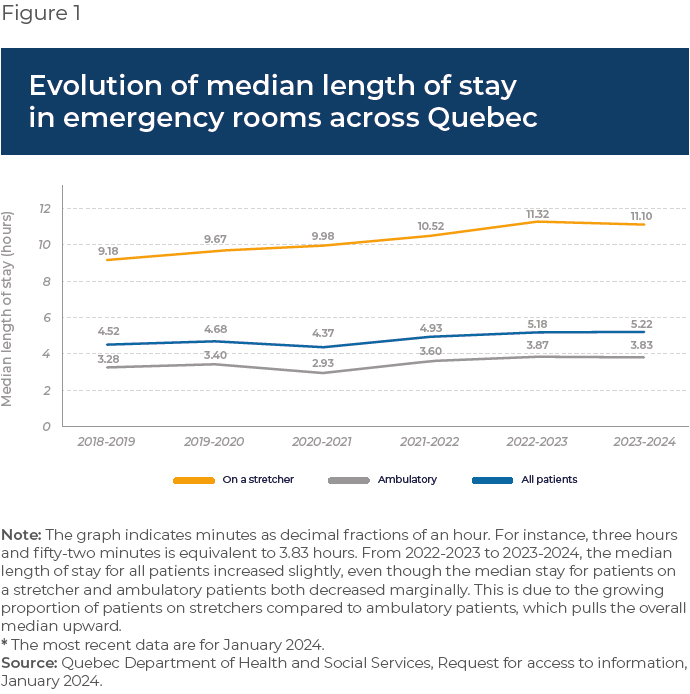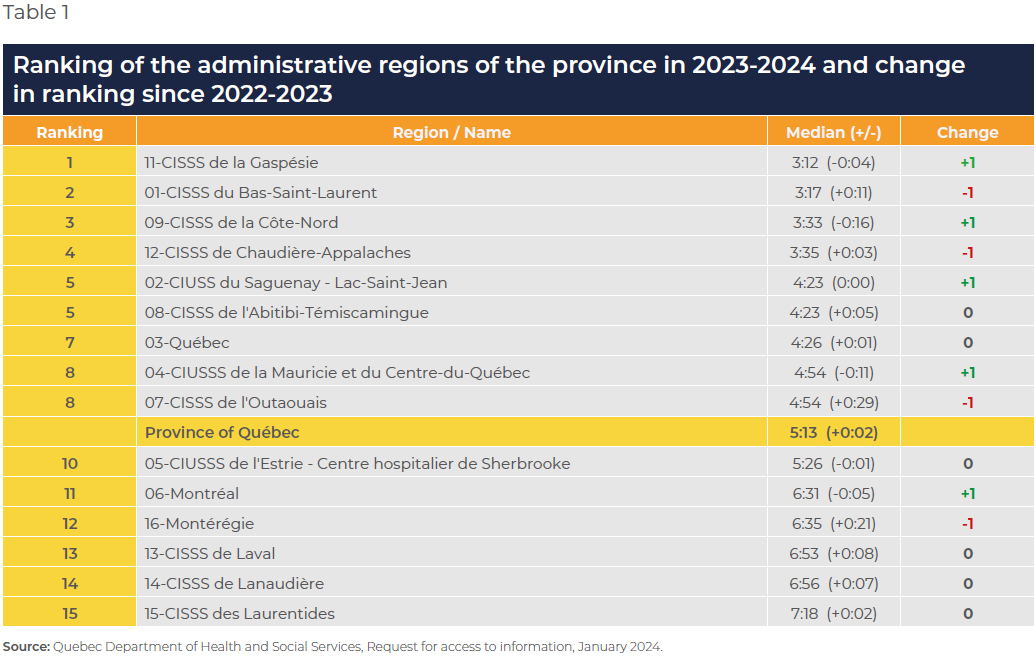ER Wait Times in Quebec Are Stagnating

Viewpoint illustrating the Quebec hospital system’s lack of improvement and the need to modify the incentives of administrators to encourage innovation and efficiency gains
 Related Content
Related Content
This Viewpoint was prepared by Emmanuelle B. Faubert, Economist at the MEI. The MEI’s Health Policy Series aims to examine the extent to which freedom of choice and entrepreneurship lead to improvements in the quality and efficiency of health care services for all patients.
Nearly 10,000 people visit hospital emergency rooms in Quebec every day. The provincial government has made many promises and launched numerous reforms in recent decades aiming to reduce wait times, but emergency rooms are as overcrowded as ever. In order to improve the situation, we need to turn to new solutions based on competition that will deliver better front-line care.
Several indicators help to analyze the situation in the province’s emergency rooms.
Overall Median Length of Stay(1)
This indicator refers to the total length of time spent in an emergency room, from registration to departure, whether a patient leaves for home or is hospitalized in another department.
The most recent data on emergency room visits show that the situation is not improving. Indeed, the median length of stay in the province’s emergency rooms in 2023-2024 was five hours and thirteen minutes, compared to five hours and eleven minutes in 2022-2023(2) (see Figure 1). While the wait was just two minutes longer than the previous year, the increase over five years has been a much more substantial 42 minutes.

Median Length of Stay on a Stretcher
This indicator reflects the length of stay for those requiring a stretcher. The situation improved very slightly for these patients.
The median stay was eleven hours and six minutes in 2023-2024, compared to eleven hours and nineteen minutes in 2022-2023. However, this is still far longer than five years ago, when such patients waited nine hours and eleven minutes.
While 24.3% of patients on stretchers had spent over 24 hours in an emergency room in 2022-2023, this proportion fell to 23.1% in 2023-2024. This nonetheless remains much higher than the 16.6% recorded in 2018-2019, before the pandemic.
Occupancy Rate of Stretchers
This rate, another indicator which illustrates the limited capacity of the hospital system compared to the strong demand, regularly exceeds 100%. When all stretchers are occupied, the limited resources of caregivers result in the rationing of care, which can lead to dangerous situations for patients.(3) The last time the occupancy rate of stretchers respected the government’s 85% target was in January 2021.(4)
Median Ambulatory Length of Stay
This indicator corresponds to the emergency room wait time for patients not requiring a stretcher. This median length of stay was two minutes shorter, going from three hours and fifty-two minutes in 2022-2023 to three hours and fifty minutes in 2023-2024.
Regional Comparisons
There is a large disparity between the different regions of the province in terms of ER wait times (see Table 1). Indeed, the median length of stay in the emergency rooms of the CISSS des Laurentides exceeded that of the CISSS de la Gaspésie by four hours and six minutes. Moreover, the Gatineau region, included in the CISSS de l’Outaouais, saw its situation deteriorate. The median length of stay in the Hull and Gatineau hospitals increased by an hour and fifty-four minutes and an hour and twenty-nine minutes, respectively, in one year.

The Annex presents in detail the situation in each of the regions of Quebec and provides a ranking of all the emergency rooms in the province in 2023-2024, as well as the change in ranking since 2022-2023.
The stagnation of wait times at levels much higher than they were five years ago shows that the government needs to move away from the usual, seemingly ineffective solutions, and instead adopt approaches based on competition in order to reduce the pressure on the resources of the hospital system.
Approaches Based on Competition
Competition-based approaches in health care aim to modify the incentives of administrators and encourage innovation, thereby leading to efficiency gains. Certain projects already announced by the government that are inspired by such approaches have the potential to really improve the situation in the province’s emergency rooms.
First, there is the independent mini-hospitals project promised by the Coalition Avenir Québec during the last election campaign, which in theory combines the flexibility of independent, decentralized administration with patient-based funding. As we already noted in a recent publication, it is crucial that this project gets built on solid foundations.(5)
Second, specialized nurse clinics are another way to reduce pressure on the hospital system by providing a new access point for primary care.(6) These clinics have already been up and running in Quebec and Ontario for several years. Teams led by specialized nurse practitioners provide local services adapted to the needs of the community. They are entirely capable of taking charge of a portion of the 642,000 Quebecers waiting for a family doctor, which would help avoid many emergency room visits through preventive action.(7)
Moreover, these clinics offer more flexibility and autonomy to nursing staff in practising their profession. The government plans to open 23 of these kinds of clinics by 2028, a beneficial approach both for patients and for nurses who do not want to work in the hospital system.(8)
The lack of improvement in emergency room wait times illustrates the importance of emphasizing innovation. Our health care system’s capacity to provide care must increase in order to treat more front-line patients with the resources currently available.
References
- Median length of stay: This indicator shows us how much time the person at the 50th percentile spent in an emergency room. This means that 50% of people visiting an ER spent less time there, and the other half spent more. This indicator is more representative than the mean, which is distorted by extreme data values.
- The mean length of stay, for its part, was two minutes shorter than in 2022-2023. A reduction in the mean while the median increases indicates a slightly shorter wait for extreme cases. Quebec Department of Health and Social Services, Request for access to information, January 2024.
- Fédération Interprofessionnelle de la santé du Québec, Quels sont les soins non faits? consulted on February 21, 2024.
- Government of Quebec, Tableau de bord – Performance du réseau de la santé et des services sociaux, Urgence, consulted on February 19, 2024.
- Emmanuelle B. Faubert, “The Mini-Hospitals Must Be Built on Solid Foundations,” MEI, Viewpoint, February 2024, p. 2.
- Emmanuelle B. Faubert and Krystle Wittevrongel, “Short on family doctors? Nurse practitioners can help,” Edmonton Journal, November 22, 2023; Government of Quebec, Health, Specialized nurse practitioners, Public specialized nurse practitioner (SNP) clinics, November 17, 2023.
- Government of Quebec, Évolution du nombre de personnes inscrites au Guichet d’accès à un médecin de famille (GAMF) selon leur statut, 2018 à 2024, January 25, 2024.
- Government of Quebec, op. cit., endnote 6.




